必修四unit 4 body language课文翻译
- 格式:doc
- 大小:13.00 KB
- 文档页数:1
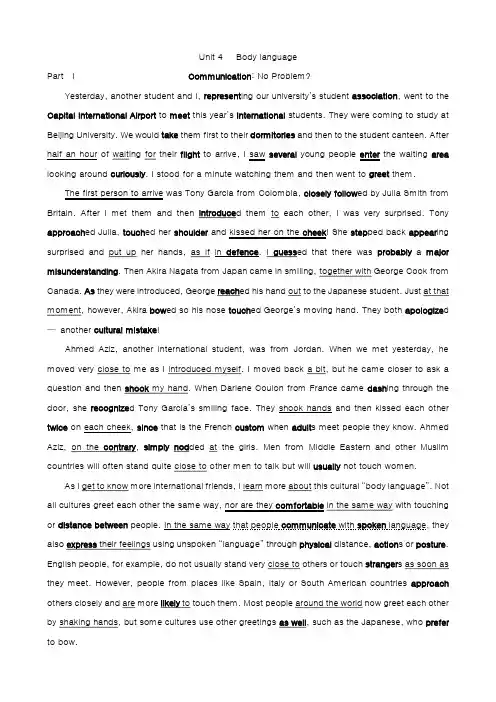
Unit 4Body languagePart I Communication: No Problem?Yesterday, another student and I, represent ing our university’s student association, went to the Capital International Airport to meet this year’s international students. They were coming to study at Beijing University. We would take them first to their dormitories and then to the student canteen. After half an hour of waiting for their flight to arrive, I saw several enter the waiting area looking around curiously. I stood for a minute watching them and then went to greet them.The first person to arrive was Tony Garcia from Colombia, closely follow ed by Julia Smith from Britain. After I met them and then introduce d them to each other, I was very surprised. Tony approach ed Julia, touch ed her shoulder and kissed her on the cheek! She step ped back appear ing surprised and put up her hands, as if in defence. I guess ed that there was probably a major misunderstanding. Then Akira Nagata from Japan came in smiling, together with George Cook from Canada. As they were introduced, George reach ed his hand out to the Japanese student. Just at that moment, however, Akira bow ed so his nose touch ed George’s moving hand. They both apologize d —another cultural mistake!Ahmed Aziz, another international student, was from Jordan. When we met yesterday, he moved very close to me as I introduced myself. I moved back a bit, but he came closer to ask a question and then shook my hand. When Darlene Coulon from France came dash ing through the door, she recognize d Tony Garcia’s smiling face. They shook hands and then kissed each other twice on each cheek, since that is the French custom when adult s meet people they know. Ahmed Aziz, on the contrary, simply nod ded at the girls. Men from Middle Eastern and other Muslim countries will often stand quite close to other men to talk but will usually not touch women.As I get to know more international friends, I learn more about this cultural “body language”. Not all cultures greet each other the same way, nor are they comfortable in the same way with touching or distance between people. In the same way that people communicate with spoken language, they also express their feelings using unspoken “language” through physical distance, action s or posture. English people, for example, do not usually stand very close to others or touch stranger s as soon as they meet. However, people from places like Spain, Italy or South American countries approach others closely and are more likely to touch them. Most people around the world now greet each other by shaking hands, but some cultures use other greetings as well, such as the Japanese, who prefer to bow.These actions are not good or bad, but are simply ways in which cultures have develope d. I have seen, however, that cultural customs for body language are very general - not all member s of a culture behave in the same way. In general, though, studying international custom s can certainly help avoid difficulties in today’s world of cultural crossroad s!Part II Showing our FeelingsBody language is one of the most powerful means of communication, often even more powerful than spoken language. People around the world show all kinds of feelings, wishes and attitude s that they might never speak aloud. It is possible to “read” others around us, even if they do not intend for us to catch their unspoken communication. Of course, body language can be misread, but many gesture s and actions are universal.The most universal facial expression is, of course, the smile – its function is to show happiness and put people at ease. It does not always mean that we are truly happy, however. Smiles around the world can be false, hiding other feelings like anger, fear or worry. There are unhappy smiles, such as when someone “loses face” and smiles to hide it. However, the general purpose of smiling is to show good feelings.From the time we are babies, we show unhappiness or anger by frown ing. In most places around the world, frowning and turning one’s back to someone shows anger. Making a fist and shaking it almost always means that someone is angry and threaten ing another person.There are many ways around the world to show agreement, but nod ding the head up and down is used for agreement, almost worldwide. Most people also understand that shaking the head from side to side means disagreement or refusal.How about showing that I am bore d? Looking away from people or yawn ing will, in most cases, make me appear to be uninterested. However, if I turn toward and look at someone or something, people from almost every culture will think that I am interested. If I roll my eyes and turn my head away, I most likely do not believe what I am hearing or do not like it.Being respectful to people is subjective, base d on each culture, but in general it is probably not a good idea to give a hug to a boss or teacher. In almost every culture, it is not usually good to stand too close to someone of a higher rank. Standing at a little distance with open hands will show that I am willing to listen.With so many cultural differences between people, it is great to have some similarities in body language. We can often be wrong about each other, so it is an amazing thing that we understand each other as well as we do!。
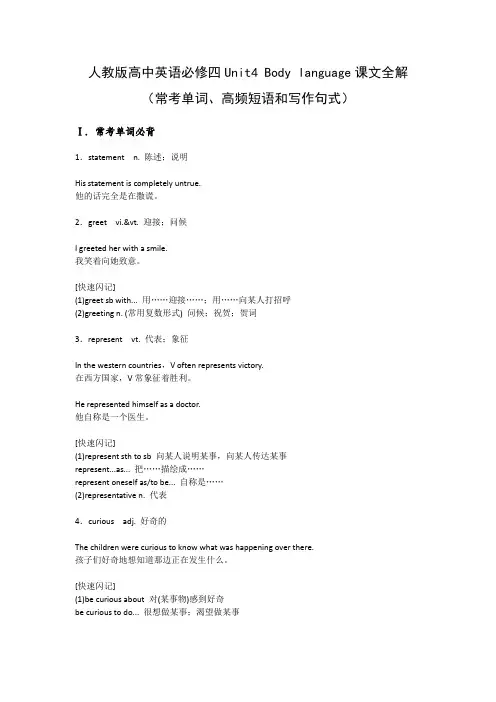
人教版高中英语必修四Unit4 Body language课文全解(常考单词、高频短语和写作句式)Ⅰ. 常考单词必背1.statement n. 陈述;说明His statement is completely untrue.他的话完全是在撒谎。
2.greet vi.&vt. 迎接;问候I greeted her with a smile.我笑着向她致意。
[快速闪记](1)greet sb with... 用……迎接……;用……向某人打招呼(2)greeting n. (常用复数形式) 问候;祝贺;贺词3.represent vt. 代表;象征In the western countries,V often represents victory.在西方国家,V常象征着胜利。
He represented himself as a doctor.他自称是一个医生。
[快速闪记](1)represent sth to sb 向某人说明某事,向某人传达某事represent...as... 把……描绘成……represent oneself as/to be... 自称是……(2)representative n. 代表4.curious adj. 好奇的The children were curious to know what was happening over there.孩子们好奇地想知道那边正在发生什么。
[快速闪记](1)be curious about 对(某事物)感到好奇be curious to do... 很想做某事;渴望做某事(2)curiously adv. 好奇地5.approach vt..&vi.接近;靠近;走近n. 接近;方法;途径As summer approached,the weather became hotter and hotter.随着夏天的临近,天气越来越热了。

![人教新课标高中英语必修4 Unit4 Body language[背景文章及课本图片] Hand](https://uimg.taocdn.com/92cf15591a37f111f0855b86.webp)
Hand SignsGenerally listed in order of frequency, hand signs are very circumstantial. Men use them more than women, though this will depend on who is watching. As a foreign male, students generally feel freer using hand language with me, than, for example, with my wife who is Japanese and commands more authority and thus more respectful formality. Also, as I wish to be aware of the feelings and opinions of my students, I often intercept messages not meant for my eyes.1. ‘Come here’ (Chotto...oide)Used when calling someone towards you, this gesture resembles a Western-style good-bye, often confusing foreigners. With a somewhat limp wrist, flap four fingers in the direction of the person you want to attract. Generally not recommended for superiors, it is still considered preferable to yelling.2. ‘Good-bye’(often accompanied with the English loan-word "bye-bye") Fingers fully extended, the hand moved left and right rapidly. Compare with the Japanese ‘Come here’ #1.3. NoWaving the hand, thumb towards the face, back and forth as if fanning in short strokes, means no, not me, or no thank you, depending on the situation. Used a great deal by students who do not know the appropriate English expression, or to avoid being embarrassed about their inability to speak English. The more emphatic the wave the more emphatic the ‘No’.4. ‘Excuse me’ (Sumimasen)Used when cutting between two people, or as a general apology. Derived from a Buddhist sign for blessing, similar to the two-handed salutation used in Southeast Asia but with only one hand. Hand flat, thumb near the nose, head and back slightly bent, eyes averted downward.5. Writing Kanji (Chinese Characters)A form of thinking out loud, or spelling out a message, Japanese often write with their finger, onto the palm of their hand, on their thigh when sitting, or into the air. By visualizing the character it helps to distinguish which character from several with the same pronunciation.6. Peace/Victory SignCan on rare occasions have the meaning of Peace, as in ‘I didn't mean to make you angry’, yet most commonly used as a playful gesture when posing for snapshots. Also commonly used as a symbol of success, as in the successful completion of a difficult question. Primarily used by students when clowning for friends, this is sometimes used as a greeting to foreigners.7. Jan-Ken (Choosing)This is the first hand game learned by children. This important game is used often by students to choose someone from a group of two or more, as when determining who goes first or who gets the last piece of candy.Players shout "Jan ken pon!" and simultaneously form their hands into one of three possible shapes. Gu a stone, Choki scissors, or Pa paper.A stone defeats scissors, because scissors cannot cut a stone. Paper defeats a stone, because paper can wrap a stone. Scissors defeat paper, because scissors can cut paper.8. CountingOpposite to that of the West, when counting start with the fingers extended, and then fold fingers into a fist, starting with the thumb and finishing with the little finger.Using the same hand folded in a fist raise the little finger for six, and continue until an open hand again.Adjusting to this system quickly can prevent misunderstandings during game playing, remember, for example, the Japanese sign for ‘two’reads ‘three’ to the Western eye.9. Indicating numbersWith a closed fist, raise the index finger for one, middle and index for two, etc. using the thumb last.10. "Something smells" (Kusai!)Very similar to the West, these can be used quite innocently, or to be insulting. Describes all bad smells including bad breath and body odor, but not in the American sense of "That movie stunk!" (That movie was bad). Done by pinching the nose with the index finger and thumb, And/or by waving the hand, as if fanning away a bad smell, in front of the face.I have found that Japanese students are generally sensitive to smells. At times I too have been tempted to use the gesture, but do not, for in Japan cleanliness is next to Godliness, and accusing someone of smelling, justified or not, can be a grave insult.11. Oni (goblin)Indicates an angry person. Both Index fingers extend upward and slightly forward, on either side of the head like horns, usually the head is tilted slightly forward. Wiggle the fingers for emphasis. Often used by students when talking about their parents, I've seen one class use it to warn the next class of my bad mood.12. "Let's go eat."Index and middle finger extended in front of mouth to resemble chopsticks, as if shoveling food from the other hand, which is cupped like a bowl. Students have used this to remind me to break for lunch.13. Laying it on ThickA hand gesture of grinding as if with a mortar and pestle, is used to describe someone exaggerating or complimenting in order to seek favor.14. MoneyFingers in the shape of a coin. Similar to an OK sign with an accent on the roundness. Traditionally discussing money was considered vulgar. Samurai seldom touched money. So this sign, though common among males, is not encouraged.15. Pa! (Coo-Coo!, Crazy!)Place a fist along side the head and open it quickly, suggests someone is stupid or crazy. Used both in fun or in criticism, as in the West.16. Tengu (Long-nosed goblin)Describes a conceited braggart. A clenched fist held in front of the face, suggesting a long nose, like the goblin Tengu.17. Clashing SwordsPeople are quarreling, can be indicated by hitting the index fingers together as if in a sword fight.18. Let's go for a drink/We went drinkingImitates a sake cup tipped for drinking. Fingers, as if holding a small sake cup, tilted towards the mouth as when drinking.Though originally used by business men, college students use this when talking about their drinking escapades. More recently, chugging a beer glass symbolically has replaced the traditional sake cup.19. SushiResembles how sushi chefs prepare sushi and is used when talking about sushi. Index and middle finger of one hand slapped into the palm of the other. As sushi is a special kind of meal this means only sushi and not for eating generally (see #12 for eating in general).20. PromiseTo make a solemn promise lock little fingers with someone. Though a bit childish I have actually seen the Prime Minister of Japan use it to accent a point.21. Father FigureThe thumb raised can mean father, the boss, or a superior.22. WomanRaised little finger, can be some what vulgar when suggesting a married man's lover. It is often used recently in humorous TV commercials and so now in classroom humor. Suggests a woman is involved in some way .23. To stealTraditionally used among thieves to suggest stealing or when talking about a thief. I have seen this used among male college students, in both seriousness in discussing a loss or in humor. Hook the index finger. Students have used this with a nod to suggest a wrong doing, without actually mentioning any names.24. PregnancyA subtle sign for pregnancy is vomiting, used primarily in theater and on TV, though I have seen students use this when teasing each other.A more direct hand sign is to move the hand in front of the stomach in a rounded arch, depicting the shape of a pregnant women. This is not considered rude unless of course the pregnancy is unwanted or a secret. Usually used instead of actually saying what may be a delicate matter.This was used in my class once, to explain a student's absence. I assumed she was having an abortion. It was also used after students learned my wife and I were expecting a child. Students when not knowing appropriate Western etiquette will often use body gestures before asking directly.There are a variety of Japanese gestures for sexual acts, as well as students who may have learned the Western equivalents, and I see them used among male students often, much in the same way they are used by male students in the West, though generally not as overtly.第11页共11页。
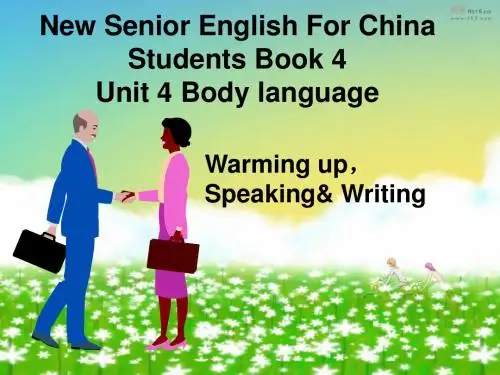
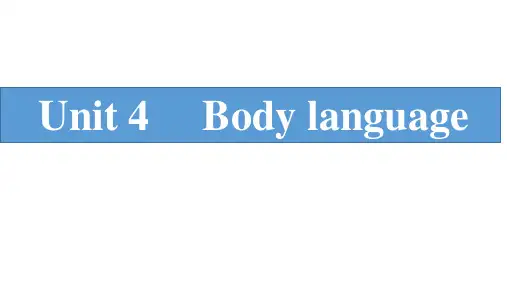
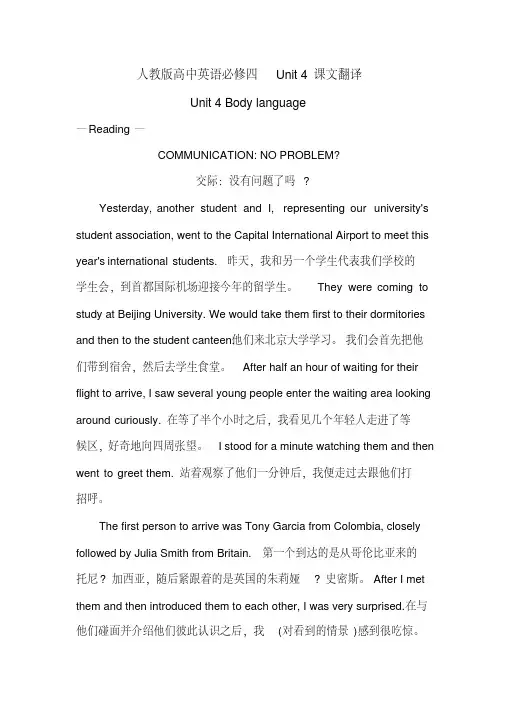
人教版高中英语必修四Unit 4课文翻译Unit 4 Body language―Reading―COMMUNICATION: NO PROBLEM?交际:没有问题了吗?Yesterday, another student and I, representing our university's student association, went to the Capital International Airport to meet this year's international students. 昨天,我和另一个学生代表我们学校的学生会,到首都国际机场迎接今年的留学生。
They were coming to study at Beijing University. We would take them first to their dormitories and then to the student canteen. 他们来北京大学学习。
我们会首先把他们带到宿舍,然后去学生食堂。
After half an hour of waiting for their flight to arrive, I saw several young people enter the waiting area looking around curiously. 在等了半个小时之后,我看见几个年轻人走进了等候区,好奇地向四周张望。
I stood for a minute watching them and then went to greet them. 站着观察了他们一分钟后,我便走过去跟他们打招呼。
The first person to arrive was Tony Garcia from Colombia, closely followed by Julia Smith from Britain. 第一个到达的是从哥伦比亚来的托尼?加西亚,随后紧跟着的是英国的朱莉娅?史密斯。
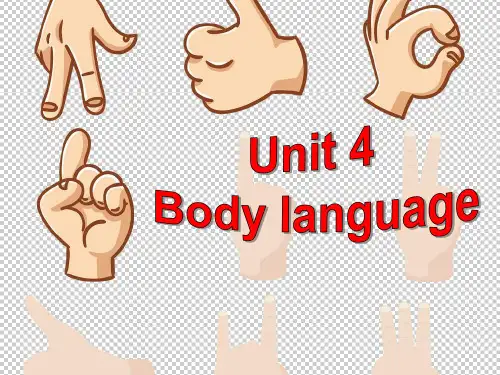
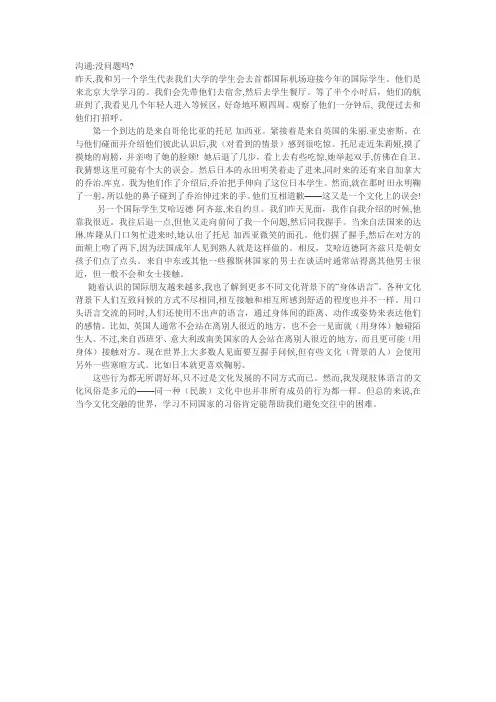
沟通:没问题吗?昨天,我和另一个学生代表我们大学的学生会去首都国际机场迎接今年的国际学生。
他们是来北京大学学习的。
我们会先带他们去宿舍,然后去学生餐厅。
等了半个小时后,他们的航班到了,我看见几个年轻人进入等候区,好奇地环顾四周。
观察了他们一分钟后, 我便过去和他们打招呼。
第一个到达的是来自哥伦比亚的托尼·加西亚。
紧接着是来自英国的朱丽.亚史密斯。
在与他们碰面并介绍他们彼此认识后,我(对看到的情景)感到很吃惊。
托尼走近朱莉娅,摸了摸她的肩膀,并亲吻了她的脸颊! 她后退了几步,看上去有些吃惊,她举起双手,仿佛在自卫。
我猜想这里可能有个大的误会。
然后日本的永田明笑着走了进来,同时来的还有来自加拿大的乔治.库克。
我为他们作了介绍后,乔治把手伸向了这位日本学生。
然而,就在那时田永明鞠了一躬,所以他的鼻子碰到了乔治伸过来的手。
他们互相道歉——这又是一个文化上的误会!另一个国际学生艾哈迈德·阿齐兹,来自约旦。
我们昨天见面,我作自我介绍的时候,他靠我很近。
我往后退一点,但他又走向前问了我一个问题,然后同我握手。
当来自法国来的达琳.库隆从门口匆忙进来时,她认出了托尼·加西亚微笑的面孔。
他们握了握手,然后在对方的面颊上吻了两下,因为法国成年人见到熟人就是这样做的。
相反,艾哈迈德阿齐兹只是朝女孩子们点了点头。
来自中东或其他一些穆斯林国家的男士在谈话时通常站得离其他男士很近,但一般不会和女士接触。
随着认识的国际朋友越来越多,我也了解到更多不同文化背景下的“身体语言”。
各种文化背景下人们互致问候的方式不尽相同,相互接触和相互所感到舒适的程度也并不一样。
用口头语言交流的同时,人们还使用不出声的语言,通过身体间的距离、动作或姿势来表达他们的感情。
比如, 英国人通常不会站在离别人很近的地方,也不会一见面就(用身体)触碰陌生人。
不过,来自西班牙、意大利或南美国家的人会站在离别人很近的地方,而且更可能(用身体)接触对方。
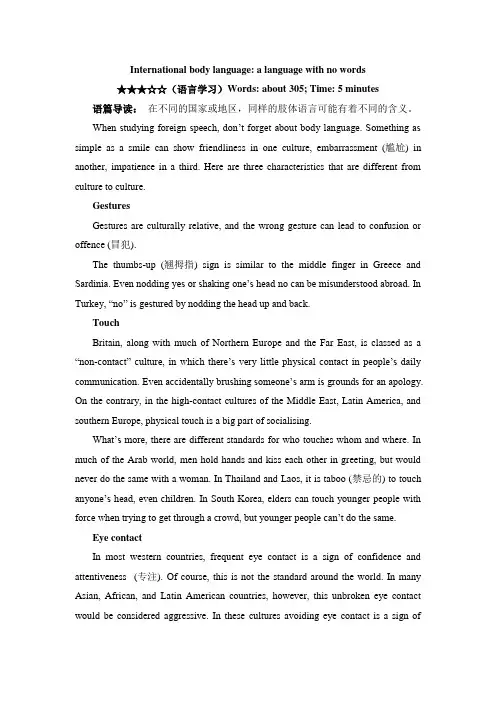
International body language: a language with no words★★★☆☆(语言学习)Words: about 305; Time: 5 minutes 语篇导读:在不同的国家或地区,同样的肢体语言可能有着不同的含义。
When studying foreign speech, don’t forget about body language. Something as simple as a smile can show friendliness in one culture, embarrassment (尴尬) in another, impatience in a third. Here are three characteristics that are different from culture to culture.GesturesGestures are culturally relative, and the wrong gesture can lead to confusion or offence (冒犯).The thumbs-up (翘拇指) sign is similar to the middle finger in Greece and Sardinia. Even nodding yes or shaking one’s head no can be misunderstood abroad. In Turkey, “no” is gestured by nodding the head up and back.TouchBritain, along with much of Northern Europe and the Far East, is classed as a “non-contact” culture, in which there’s very little physical contact in people’s daily communication. Even accidentally brushing someone’s arm is grounds for an apology. On the contrary, in the high-contact cultures of the Middle East, Latin America, and southern Europe, physical touch is a big part of socialising.What’s more, t here are different standards for who touches whom and where. In much of the Arab world, men hold hands and kiss each other in greeting, but would never do the same with a woman. In Thailand and Laos, it is taboo (禁忌的) to touch anyone’s head, even children. In South Korea, elders can touch younger people with force when trying to get through a crowd, but younger people can’t do the same.Eye contactIn most western countries, frequent eye contact is a sign of confidence and attentiveness (专注). Of course, this is not the standard around the world. In many Asian, African, and Latin American countries, however, this unbroken eye contact would be considered aggressive. In these cultures avoiding eye contact is a sign ofrespect for bosses and elders. Children won’t look at an adult who is speaking to them, and nor will employees to their bosses.。
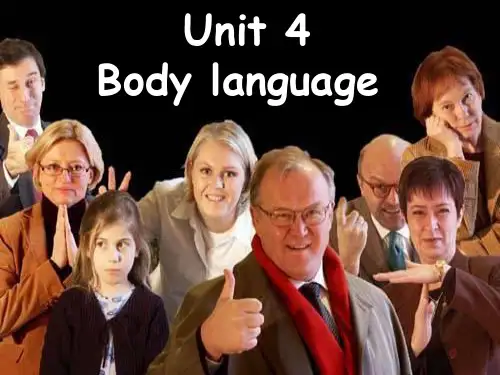
1.必修四Module1 The City of the Future未来城市What will the city of the future look like?未来的城市会是什么样子呢?No one knows for sure, and making predictions is a risky business. 没有人确切的了解,预测也是一件很危险的事情。
But one thing is certain---they are going to get bigger before they get smaller.但是有一件事情是可以肯定的---他们将会先变大,然后再变小。
In the future, care for the environment will become very important as earth's natural resources run out. 在未来,爱护环境将会很重要,因为地球的资源将濒临枯竭。
We will use lots of recycled materials, such as plastic, aluminum, steel, glass, wood and paper, and we will waste fewer natural resources. 我们将会使用大量的可回收材料,例如,塑料、铝、钢铁、玻璃、木头和纸。
我们浪费自然资源的程度将会有所减弱。
We will also have to rely more on alternative energy, such as solar and wind power.我们也将不得不更多地依赖其他能源。
例如,太阳能和风能。
All this seems certain, but there are plenty of things about city life in the future which are not certain. 所有的这些似乎是肯定的,但是还有许多关于城市生活的事情仍是未知的。
握手是人与人问候的基本礼仪,但方式不同,表达的意义也大不相同。
The Secret of the Successful HandshakeThe secret of the successful handshake is no secret anymore.Management consultant Robert E. Brown explains what shaking handsis all about in his book, The Art, the Po w er, the Magic: Ho w to ReadHands That Talk.For example, to do the “AllAmerican Handshake”,you have to look into another person’s eyes, hold his or her whole hand, two or three times. According to Brown, this is the handshake of a good listener and trustworthy person.Politicians and salespeople often use the “TwoHanded Handshake”because it’s extrafriendly. They put their left hand on the other per son’s arm or shoulder as they shake hands. This can feel too friendly to some people, so it’s best to use it with good friends.Watch out for people with handshakes that pull your fingers, or twist(扭转) your hand. If you get one of these handshakes, the person is trying to intimidate(恐吓) you.Two more uncomfortable handshakes are the “Palm Pinch”and the “Dead Fish”. A Palm Pincher shakes your hand with only a few fingers. In the Dead Fish handshake, the person’s hand slides out of the handshake. It’s possible that the people with these handshakes areembarrassed(尴尬的) or shy.Shaking hands is an important part of body language. It can identify someone as truthful, friendly, powerful, or nervous. It’s hard to be successful without knowing about a good handshake such as the AllAmerican. If this isn’t your natural handshake, don’t worry. Mr Brown says that you can change your handshake with lots of practice. So, go on out there and start shaking hands. Just think of all the people you can meet!Section ⅠWarming Up & Reading—Comprehending重点单词写作词汇1.dormitory n. 宿舍2.canteen n. 食堂3.approach v t.& v i. 接近;靠近;走近n. 接近;方法;途径4.cheek n. 面颊5.major adj. 主要的6.adult n. 成人;成年人adj. 成人的;成熟的7.dash v i. 猛冲;突进8.flight__n. 飞行;航班拓展词汇9.likely adj.可能的→unlikely adj.不可能的10.statement n.陈述;说明→state v.陈述;说明11.greet v i.& v t.迎接;问候→greeting n.迎接;问候;招呼12.represent v t.代表;象征→representation n.代表,代表团;代理→representative adj.代表性的n.代表,代理人13.association n.社团;联系;联想→associate v.把……联系起来14.curious adj.好奇的→curiously ad v.好奇地→curiosity n.好奇心15.defend v t.保护;保卫→defence n.防御;保卫16.misunderstand v t.误解;误会→misunderstanding n.误解;误会阅读词汇17.simply ad v. 简单地;只18.Muslim n.& adj. 穆斯林(的);__伊斯兰教信徒(的)19.posture n. 姿势;体态20.crossroads n. 十字路口重点短语1.put__up 举起;抬起2.in__defence 保卫;防御3.kiss__sb.on__the__cheek 亲吻某人的脸4.be__likely__to 很可能……;有希望……5.in__general 总的来说;通常6.defend...against 防御;保卫……以免受重点句型1.the first/second/.../last+名词+to do...:The__first__person__to__arrive(第一个到达的人) was Tony Garcia from Colombia, closely followed by Julia Smith from Britain.2.状语从句的省略:She stepped back appearing surprised and put up her hands,as__if__in__defence(好像是在自卫).3.not all...表示部分否定:Not__all__cultures(并不是所有文化) greet each other the same way, nor are they comfortable in the same way with touching or distance between people.ⅠFast-readingSkim the text and do the following exercises.1.What does the text mainly talk about?A.Communication. B.Spoken language.C.Body language. D.Different cultures.答案:C2.Match the main idea of each paragraph.Para.1A.To suggest studying international customs.Paras.2-3 B.To meet the international students at the Capital International Airport.Para.4 C.To introduce the students to each other and explain their different ways of greeting.Para.5 D.To explain different cultural “body language”in some countries.答案:BCDAⅡCareful-readingRead the text carefully and choose the best answer.1.In which of the following countries do people greet each other in the same way?A.Colombia and Britain.B.Spain and Italy.C.France and Jordan.D.China and Japan.2.How does the text develop?A.By giving examples. B.By giving data.C.By giving definition. D.By making comparisons.3.What’s the purpose of the second paragraph?A.To give examples of mistakes the international students make.B.To give examples of cultural differences in body language.C.To show how surprised we are by their different behavior.D.To show how important body language is.4.What can we learn from the passage?A.Never too old to learn.B.When in Rome, do as the Romans do.C.Four eyes see more than two.D.Every country has its own customs.答案:1-4.BABBⅢStudy-readingAnalyze the following difficult sentences in the text.1.They shook hands and then kissed each other twice on each cheek, since that is the French custom when adults meet people they know.本句是一个复合句。
Ⅰ.阅读理解ARecently||,I had lunch with a young Chinese student who studies at a college in New York.He is very bright and aspiring and I enjoyed our conversation.Still I felt frustrated and useless afterwards because I was not able to provide him with any good news.Graduating at the end of this year||,he asked me how he could find a job in this country and fulfill his career dreams.In recent years||,students who found a job here after graduation have had to go through a cruel lottery system to obtain their HIB working visa.And the success rates have been declining year after year because of the ever growing number of st year||,there were 233||,000 applicants||,and only 30 percent of them were lucky||,less than half of the rate in 2019.And it can only become President Donald Trump's immigration policies in this country are tightening up and this trend will continue for at least the next few years.In this case||,foreign students studying social sciences||,a field in which starting salaries are rarely above the required amount||,can kiss their visa hopes goodbye.Compared to the older generation of Chinese students||,today's young people no longer consider the US as the only option.Many start to think China offers better opportunities in the longer term.This is not to say that Chinese students in the US are not interested in job opportunities here any more.A few years of work experience in the US can give them leverage when they finally land back in their home country.But if the job opportunities are largely reduced by the tightening of immigration policy||,I expect there will be a decline.And if that happens||,it is the American economy that will suffer from the loss of those educated||,hard-working and talented immigrants.[语篇解读]本文为一篇记叙文||。
沟通:没问题吗?
昨天,我和另一个学生代表我们大学的学生会去首都国际机场迎接今年的国际学生。
他们是来北京大学学习的。
我们会先带他们去宿舍,然后去学生餐厅。
等了半个小时后,他们的航班到了,我看见几个年轻人进入等候区,好奇地环顾四周。
观察了他们一分钟后, 我便过去和他们打招呼。
第一个到达的是来自哥伦比亚的托尼·加西亚。
紧接着是来自英国的朱丽.亚史密斯。
在与他们碰面并介绍他们彼此认识后,我(对看到的情景)感到很吃惊。
托尼走近朱莉娅,摸了摸她的肩膀,并亲吻了她的脸颊! 她后退了几步,看上去有些吃惊,她举起双手,仿佛在自卫。
我猜想这里可能有个大的误会。
然后日本的永田明笑着走了进来,同时来的还有来自加拿大的乔治.库克。
我为他们作了介绍后,乔治把手伸向了这位日本学生。
然而,就在那时田永明鞠了一躬,所以他的鼻子碰到了乔治伸过来的手。
他们互相道歉——这又是一个文化上的误会!
另一个国际学生艾哈迈德·阿齐兹,来自约旦。
我们昨天见面,我作自我介绍的时候,他靠我很近。
我往后退一点,但他又走向前问了我一个问题,然后同我握手。
当来自法国来的达琳.库隆从门口匆忙进来时,她认出了托尼·加西亚微笑的面孔。
他们握了握手,然后在对方的面颊上吻了两下,因为法国成年人见到熟人就是这样做的。
相反,艾哈迈德阿齐兹只是朝女孩子们点了点头。
来自中东或其他一些穆斯林国家的男士在谈话时通常站得离其他男士很近,但一般不会和女士接触。
随着认识的国际朋友越来越多,我也了解到更多不同文化背景下的“身体语言”。
各种文化背景下人们互致问候的方式不尽相同,相互接触和相互所感到舒适的程度也并不一样。
用口头语言交流的同时,人们还使用不出声的语言,通过身体间的距离、动作或姿势来表达他们的感情。
比如, 英国人通常不会站在离别人很近的地方,也不会一见面就(用身体)触碰陌生人。
不过,来自西班牙、意大利或南美国家的人会站在离别人很近的地方,而且更可能(用身体)接触对方。
现在世界上大多数人见面要互握手问候,但有些文化(背景的人)会使用另外一些寒暄方式。
比如日本就更喜欢鞠躬。
这些行为都无所谓好坏,只不过是文化发展的不同方式而已。
然而,我发现肢体语言的文化风俗是多元的——同一种(民族)文化中也并非所有成员的行为都一样。
但总的来说,在当今文化交融的世界,学习不同国家的习俗肯定能帮助我们避免交往中的困难。